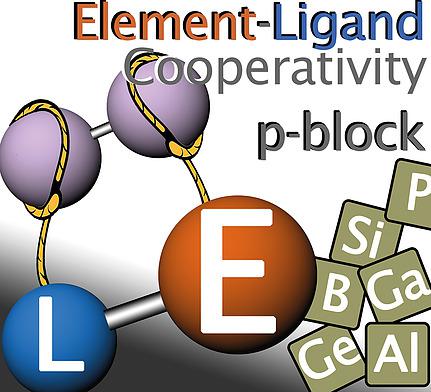当前位置:
X-MOL 学术
›
Eur. J. Inorg. Chem.
›
论文详情
Our official English website, www.x-mol.net, welcomes your feedback! (Note: you will need to create a separate account there.)
Element‐Ligand Cooperativity with p‐Block Elements
European Journal of Inorganic Chemistry ( IF 2.3 ) Pub Date : 2020-06-25 , DOI: 10.1002/ejic.202000449 Lutz Greb 1 , Fabian Ebner 1 , Yael Ginzburg 1 , Lukas M. Sigmund 1
European Journal of Inorganic Chemistry ( IF 2.3 ) Pub Date : 2020-06-25 , DOI: 10.1002/ejic.202000449 Lutz Greb 1 , Fabian Ebner 1 , Yael Ginzburg 1 , Lukas M. Sigmund 1
Affiliation

|
Metal‐ligand cooperativity (MLC) had a tremendous impact on d‐block metal‐mediated bond activation and homogeneous catalysis. Is this concept translatable to the elements of the p‐block? Are there analogies already at hand? In this review, we describe contributions in which a p‐block element (group 13–15) and its ligand (surrounding molecular framework) operate synergistically in a substrate activation or a catalytic cycle. This activity is termed element‐ligand cooperativity (ELC), in correspondence to MLC. After the concepts of p‐block low‐valent states and frustrated Lewis pairs mimicking the ambiphilic reactivity of transition metals, the spatial proximity of nucleophilic and electrophilic reaction sites and a small HOMO‐LUMO gap in a p‐block ELC complex might offer yet another approach. Selected examples shall illustrate common reactivities of ELC, disclose conceptual analogies with d‐block MLC, and outline shortcomings in this field.
中文翻译:

带p块元素的元素配体协同性
金属配体协同作用(MLC)对d嵌段金属介导的键活化和均相催化具有巨大影响。这个概念可以转化为p块的元素吗?是否已经有比喻?在这篇综述中,我们描述了ap-block元素(13-15组)及其配体(周围的分子框架)在底物活化或催化循环中协同作用的贡献。对应于MLC,此活动称为元素配体协同作用(ELC)。在p嵌段低价态和沮丧的Lewis对模仿过渡金属的两亲反应性的概念之后,亲核和亲电反应位点的空间接近性以及ap嵌段ELC络合物中较小的HOMO-LUMO缺口可能提供了另一种方法。
更新日期:2020-08-24
中文翻译:

带p块元素的元素配体协同性
金属配体协同作用(MLC)对d嵌段金属介导的键活化和均相催化具有巨大影响。这个概念可以转化为p块的元素吗?是否已经有比喻?在这篇综述中,我们描述了ap-block元素(13-15组)及其配体(周围的分子框架)在底物活化或催化循环中协同作用的贡献。对应于MLC,此活动称为元素配体协同作用(ELC)。在p嵌段低价态和沮丧的Lewis对模仿过渡金属的两亲反应性的概念之后,亲核和亲电反应位点的空间接近性以及ap嵌段ELC络合物中较小的HOMO-LUMO缺口可能提供了另一种方法。


























 京公网安备 11010802027423号
京公网安备 11010802027423号